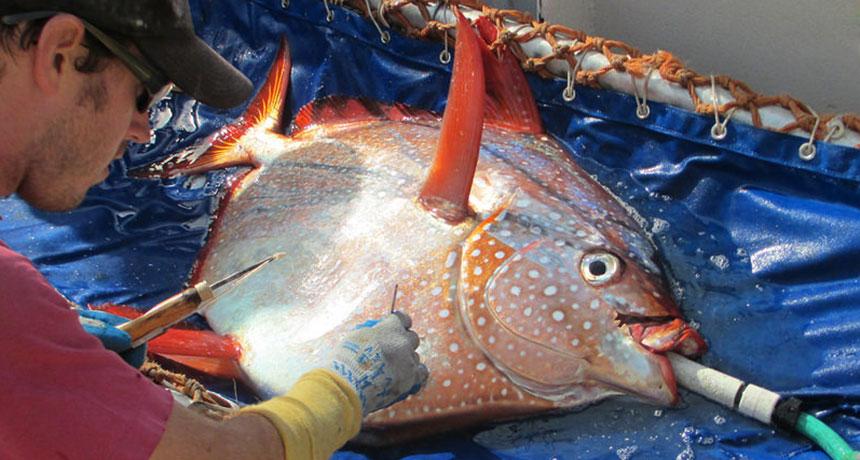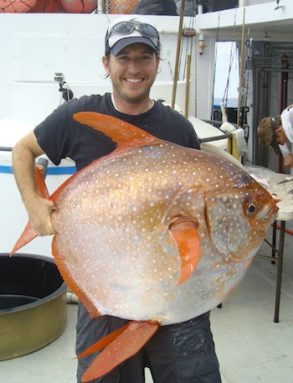This is no cold fish!
Its heated blood could give the opah a competitive edge

This opah is about as close to a full-body warm-blooded fish as science has yet discovered. Here, biologist Nick Wegner prepares to insert a temperture sensor into the animal’s pectoral muscles. The device will record internal and external temperatures following the fish’s release.
NOAA FISHERIES WEST COAST/FLICKR (CC BY-NC-ND 2.0)
By Susan Milius
Fish as a rule stay the temperature of the water around them. Not the opah. As it hunts in the ocean’s dark depths, this fish keeps much of its body distinctly warmer than the frigid water around it. That makes this species the closest of any fish to the warm-bloodedness typical of birds and mammals.
The opah (Lampris guttatus) is about the size of a car tire and almost as round. That shape helps explain why the opah is sometimes called a moonfish. This animal swims by using its large pectoral muscles to move its skinny, red pectoral fins. Those muscles also produce a lot of heat.

Its unusual gills and other heat-saving features don’t allow the opah to maintain the same high and stable body temperatures seen in mammals and birds. (Being warm-blooded, or endothermic, means those creatures can control their body temperature as their surroundings get warmer or cooler.) Still, measurements suggest that the opah can keep its heart and some other important tissues several degrees warmer than the cold water in which it swims, Wegner and his colleagues say. They described details May 15 in Science.
Biologists have found other fish that don’t fit the normal cold-blooded fish model. Ocean athletes such as tunas and white sharks, for instance, preserve warmth in muscles that power their swimming. And blue marlin and other billfish keep their eyes and brains warm. All of these fish still have to cope with hearts that eventually cool — and slow — during long dives into the cold ocean depths.
Slowing the heart delays the delivery of oxygen to muscles and other tissues. Activity levels quickly grow sluggish. A cold heart “affects everything,” says Diego Bernal. A physiologist, he works at the University of Massachusetts in Dartmouth and was not a part of the opah research.
Previous work had hinted the opah might be able to keep its eyes and brain warm. Learning of its warm heart is “the really, really interesting part,” Bernal says. “We have all these big fish out there that we love to eat, love to catch, but we know almost nothing about their basic biology.”
The first evidence for a warm heart and circulatory system came from Wegner, a self-described “gill guy.” He wasn’t expecting anything unusual when he received some opah gill specimens. He let them sit “in a bucket of formaldehyde for several months,” he says. Then Wegner noticed a tangled mass of blood vessels in those gills. He soon suspected they were for conserving heat.
(Story continues below image)

Wegner worked to sort out the complex pattern of blood flow in those gill vessels. First, he injected a blue substance from one end and a red substance from the other. Then he watched as the blue and red substances flowed toward each. They created alternating bands of color, revealing how the vessels wound together.
That suggested the web of vessels acted like a heat exchanger. Blood warmed by passing through the body of the fish took the chill off of nearby vessels. Those latter vessels carried blood that had just picked up oxygen from the cold seawater swishing through the fish’s gills. This sort of circulatory system saves heat, Wegner says.
Temperature measurements from about 20 freshly caught opah supported the idea. Their hearts, guts, heads and pectoral muscles were about 3 to 6 degrees Celsius (5.4 to 10.8 degrees Fahrenheit) warmer than the deeper ocean water where the fish had been swimming. The researchers then attached devices to four of the fish. The devices logged temperatures in the animals’ pectoral muscles. Each fish was then released for a swim. Muscle temperatures averaged about 5 degrees Celsius warmer than the surrounding seawater.
The power to conserve some of the heat generated by its body could help explain how this fish swims faster, reacts more quickly and sees better, Wegner says. Other fish that dwell at depths of up to 300 meters (1,000 feet) — as the opah do — are typically slow and sluggish.
Power Words
(for more about Power Words, click here)
cell The smallest structural and functional unit of an organism. Typically too small to see with the naked eye, it consists of watery fluid surrounded by a membrane or wall. Animals are made of anywhere from thousands to trillions of cells, depending on their size.
chemical reaction A process that involves the rearrangement of the molecules or structure of a substance, as opposed to a change in physical form (as from a solid to a gas).
circulation (in biology) A term that refers to the pumping of blood through the arteries, and smaller types of vessels (and from there into other organs and tissues).
conserve To protect, as from loss or degradation.
formaldehyde A widely used and toxic chemical that manufacturers add to plastics, resins, some fertilizers, dyes, medicines and embalming fluids. It’s even in the treatments used to keep fabrics from wrinkling.
endothermic (in biology) A term for an animal’s generation of heat to keep its body temperature comfortable when the environment turns cold.
gills The respiratory organ of most aquatic animals that that filters oxygen out of water, which fish and other water-dwelling animals use to breathe.
heat exchanger A system of pipes or fins through which heat can be released from a machine into the environment around them.
log (in research) The process of recording data for use or analysis later. For instance, doctors may ask people who take part in a drug trial to every day log how they feel and any change in their weight or health. Researchers can later go over the logs to see if and when people got better — or worse. Scientists tend to log all of the conditions of their experiments into lab notebooks. That way they can compare the findings from one test with all others — or what conditions they need to faithfully copy if they need to rerun a test.
mammal A warm-blooded animal distinguished by the possession of hair or fur, the secretion of milk by females for feeding the young, and (typically) the bearing of live young.
National Oceanographic and Atmospheric Administration, or NOAA A science agency of the U.S. Department of Commerce. Initially established in 1807 under another name (The Survey of the Coast), this agency focuses on understanding and preserving ocean resources, including fisheries, protecting marine mammals (from seals to whales), studying the seafloor and probing the upper atmosphere.
oxygen A gas that makes up about 21 percent of the atmosphere. All animals and many microorganisms need oxygen to fuel their metabolism.
pectoral An adjective for something related to an animal’s chest (or breast region).
pectoral fins The fins that emerge from the side of a fish, just behind its head. They help direct the animal’s motion. They effectively correspond to the arms (or forelimbs) of a land animal.
physiology The branch of biology that deals with the everyday functions of living organisms and how their parts function. People who work in this field are known as physiologists.
shark A type of predatory fish that has survived in one form or other for hundreds of millions of years. Cartilage, not bone, gives its body structure.
warm-blooded Adjective for animals (chiefly mammals and birds) that maintain a constant body temperature, typically above that of their surroundings. Scientists generally prefer the term endothermic to describe animals that generate heat to control their body’s temperature.







